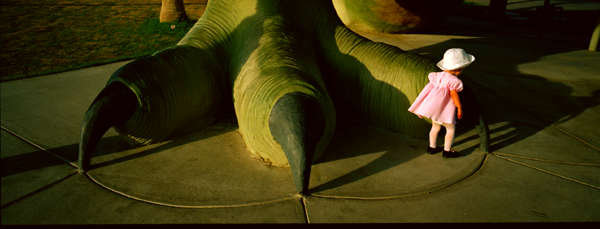| Back to MAGAZINE |
Digital
Corner
|
|
About
Digital Film and Paper In
lectures that I have given recently, a recurrent theme comes up during
the "question and answer" period: "Do you think that
schools should continue to teach traditional darkroom techniques?".

Of course any photography student should learn the fundamentals of photography, but it doesn't say that these have to be based on a chemical darkroom technology in order to be the cornerstone for such knowledge. The truth is that most of these schools that are only teaching traditional darkroom techniques are actually hurting the students more rather than helping them, if they do not bring into their teachings all that there is to know about the digital realm. The first question that should emerge is, what do you want the students to know when they come out of their photography courses? If you want for them to only know how photography was produced in the past, by all means solely teach them traditional techniques. If, however, you want to train people and provide them with the know how to get assignments and jobs in the real world by the time they finish their studies, you will make a much better case for doing so by teaching them digital technologies, in addition to any traditional ones, if need be. Let us look at a few indicators which point out the direction these issues are going: "According to the Nikkei News Service, digital cameras are selling so well in Japan that film camera sales are taking a hard hit. Statistics from the Japan Electronic Industry Development Association put digital products at 20% of the roughly 5.5 million cameras shipped in Japan in 1998 -up 7%. It says that as consumer interest shifts to digital cameras, "shipments of conventional compact cameras plummeted." ----------------------------------------- -"DigitCams cut into Film Sales", FIR Weekly Digital Imaging Briefing, issue #57 ------------------------------------------ PROFESSIONAL
PHOTOGRAPHERS' NEWSLETTER (PPN) February 10, 1999 The facts. Three out of four short-listed portfolios to find the Kodak Photographer of the Year (Paul Hackett) were shot by Reuters staff using digital cameras. -------------------------------------------

We could of course go on quoting all sorts of additional sources that tell us similar stories, in which film and paper are being gradually replaced. But the stories these would convey would have the same meaning as these few ones we have selected. The big argument, against using digital technologies, used to be that the cost of moving over was so expensive. Today that is certainly less true than ever before. To give you an example: if you purchase a Nikon Cool Pix 950 camera, with a 32 meg memory card, an Epson Stylus 1200 model printer, buying a computer just for this purpose, an iMac for instance, and use the version of PhotoShop light which you get free with the printer, you end up spending altogether around $2,600 US Dls. Your cost of paper and inks for the printer is going to be not more than the cost of papers and chemicals in the darkroom. The only real disadvantage today is that the final digital prints are less permanent than what is desirable. Having said that, there is a range of new inks coming out on the market all the time which address this problem and which should be resolving such matters very soon. The above mentioned set up should allow you to make prints up to 8 x 10 inches that have as much definition as any film based image. Like everything that happens in this field of digital technology, the moment you write something down, it's because, more likely than not, it is already superseded with something better, faster and cheaper. So as time moves on, the argument can only get better for the case of digital photography. The other day I read a very interesting article detailing how Kodak has made very large investments in China, and taken over a number of state run film and paper plants which are being modernized. There was also a description of how today Kodak had become the number one film and paper manufacturer in China. I could well imagine that they are facing out their installations in the West and gradually transferring all their film and paper equipment to that huge market. It is also plausible, as this is not the first time that this has happened, that plants which are obsolete in more developed markets get then sent to underdeveloped ones, such as is the case: China. From there they will probably be able to service (export to) the rest of the world, as the notion that film is going to disappear 100% in the near future, would be a complete fallacy. Cheap labor and already amortized plants in the West, will be a tough act to beat as far as cost of production for film and paper goes. But price alone will not drive photography markets; convenience will also play an important role.

Digital technologies will offer more and more convenience in addition to the potential for creative new solutions in markets that are more sophisticated and therefore more advanced. I can already envisage how the markets will be digital for the more advanced sectors of the world economy, and traditional chemical ones for the underdeveloped world. When Kodak announces today that film will be around for a long time to come, they are not wrong in saying so, they are just not telling the entire story. Film and paper will be around longer than consumers want it, if they have no choice. What choices the Chinese will have is shear speculation on my part, but I would not believe that it is going to be very large. So yes, probably the Chinese will have film and paper, and so will a lot lesser fortunate markets, but where there is a choice, I can hardly imagine that digital alternative is not going to win, time and time again. We are at the crossroads of several huge changes for photography. Going from analog to digital, is obviously the direction that it is all taking. It is doing so with regard to the tools and techniques for the photographer. These in turn change not only how things get done, but also what can be done with these. You could not be reading this article if you did not already have access to a computer, so for you the cost of going towards a digital solution does not necessarily entail the purchase of a computer, as most likely you already have one. This makes it even less expensive for you to explore making digital photographs.

In conclusion: students should demand from their schools, or choose the ones that offer, training in photography using digital technologies. To accept anything less, is to limit your own potential development. Understand that those who want to persuade you of the opposite is because they probably don't have enough knowledge in this area, and rather than learn about it, they want to convince you that it is not needed. They are protecting their own interests, not yours. For teachers and established photographers, I would have to say that it must be very hard to discover that you have been rendered partially obsolete in your knowledge if you are not up to date with what is going on in the digital revolution. If history is anything to go by, you will not be able to stop this erosion by dismissing it. Most probably however you will make a healthy transition, by accepting the inevitable, the digital era is here to stay, film and paper in China notwithstanding. Related links: NEW YORK
-- The market for digital photography is growing faster than you can
say "cheese." Foveon
has built a high-end digital still camera that aims to rival the quality
of analog film. Pocket-Sized
and Powerful: Epson Unveils Its First Two-Megapixel USB Digital Camera;
New PhotoPC 800 Packs the Ultimate in Performance and Image Quality
into a Compact, Portable Design. DIGITAL
STILL CAMERAS make you understand what it feels like to live in a world
of scarcity. More digital-camera
products and choices mean more deals. Toshiba
PDR-M1 |